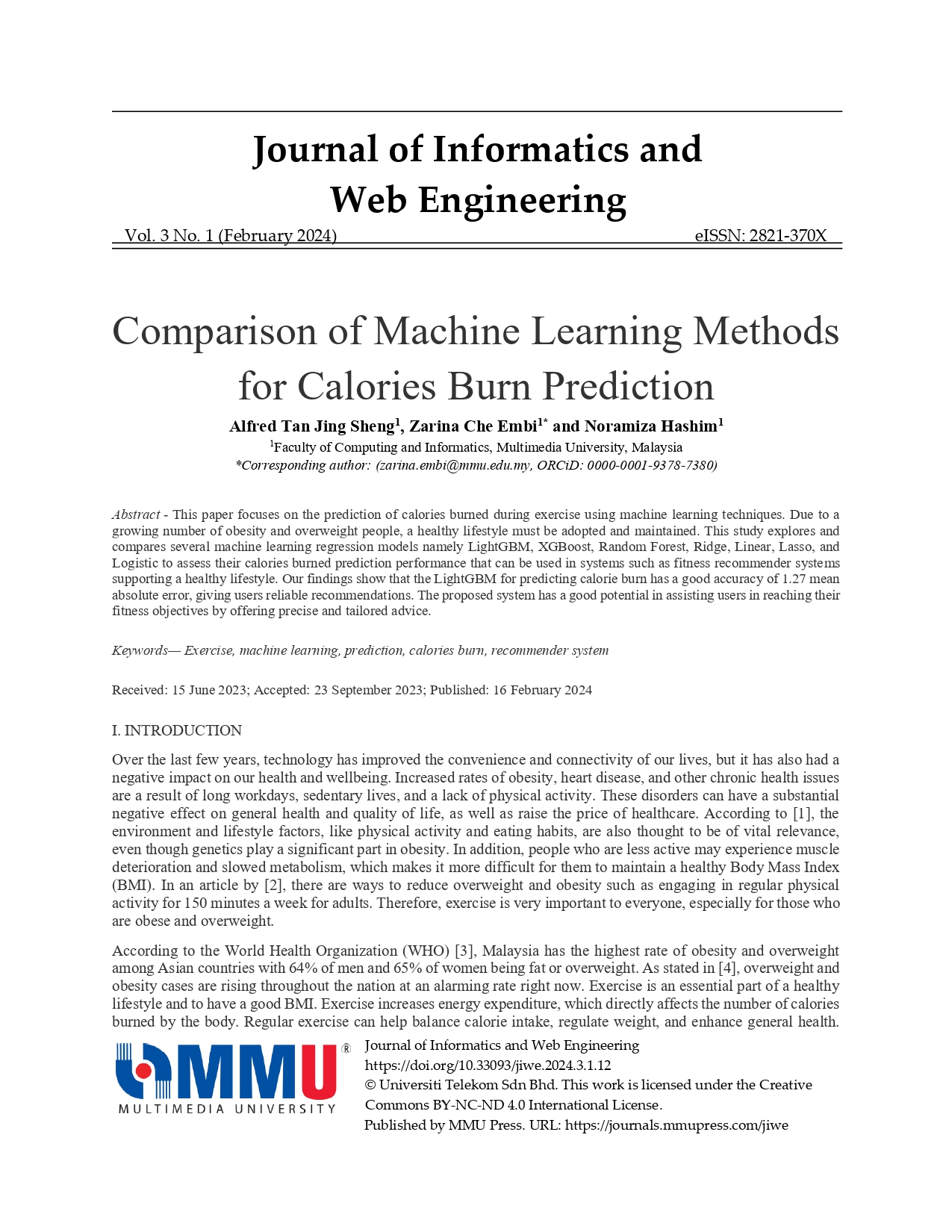Comparison of Machine Learning Methods for Calories Burn Prediction
Main Article Content
Abstract
This paper focuses on the prediction of calories burned during exercise using machine learning techniques. Due to a growing number of obesity and overweight people, a healthy lifestyle must be adopted and maintained. This study explores and compares several machine learning regression models namely LightGBM, XGBoost, Random Forest, Ridge, Linear, Lasso, and Logistic to assess their calories burned prediction performance that can be used in systems such as fitness recommender systems supporting a healthy lifestyle. Our findings show that the LightGBM for predicting calorie burn has a good accuracy of 1.27 mean absolute error, giving users reliable recommendations. The proposed system has a good potential in assisting users in reaching their fitness objectives by offering precise and tailored advice.
Article Details

This work is licensed under a Creative Commons Attribution-NonCommercial-NoDerivatives 4.0 International License.
All articles published in JIWE are licensed under a Creative Commons Attribution-NonCommercial-NoDerivatives 4.0 International (CC BY-NC-ND 4.0) License. Readers are allowed to
- Share — copy and redistribute the material in any medium or format under the following conditions:
- Attribution — You must give appropriate credit, provide a link to the license, and indicate if changes were made. You may do so in any reasonable manner, but not in any way that suggests the licensor endorses you or your use;
- NonCommercial — You may not use the material for commercial purposes;
- NoDerivatives — If you remix, transform, or build upon the material, you may not distribute the modified material.
References
X. Chen and J. Cui, "The association between BMI and health-related physical fitness among Chinese college students: a cross-sectional study," BMC Public Health, Apr. 5, 2020. [Online]. Available: https://bmcpublichealth.biomedcentral.com/articles/10.1186/s12889-020-08517-8
V. Martin, "Obesity and overweight," World Health Organization (WHO), Jun. 9, 2021. [Online]. Available: https://www.who.int/news-room/fact-sheets/detail/obesity-and-overweight
N. Kaur, "Malaysia and WHO call for more investment in primary health care in the 21st century," World Health Organization (WHO), Apr. 8, 2019. [Online]. Available: https://www.who.int/malaysia/news/detail/08-04-2019-malaysia-and-who-call-for-more-investment-in-primary-health-care-the-21st-century
Bernama, "One of two adults in Malaysia is overweight, says Deputy Health Minister," New Straits Times, Mar. 25, 2022. [Online]. Available: https://www.nst.com.my/news/nation/2022/03/783279/one-two-adults-malaysia-overweight-says-deputy-health-minister
D. D. T. D. Dakshima, K. Seliya Mindula, R. M. S. J. Rathnayake, S. Kasthuriarachchi, A. K. Buddhi Chathuranga and D. Lunugalage, "Health Care – A Personalized Guidance for Non-Communicable Diseases," 2022 4th International Conference on Advancements in Computing (ICAC), Colombo, Sri Lanka, 2022, pp. 447-452, doi: 10.1109/ICAC57685.2022.10025109.
A. Pande, J. Zhu, A. K. Das, Y. Zeng, P. Mohapatra and J. J. Han, "Using Smartphone Sensors for Improving Energy Expenditure Estimation," IEEE journal of translational engineering in health and medicine, vol. 3, 2015. doi: 10.1109/JTEHM.2015.2480082
E. E. Dooley, N. M. Golaszewski, and J. B. Bartholomew, "Estimating Accuracy at Exercise Intensities: A Comparative Study of Self-Monitoring Heart Rate and Physical Activity Wearable Devices," JMIR mHealth and uHealth, vol. 5, no. 3, 2017. doi: 10.2196/mhealth.7043
S. P. Vinoy and B. Joseph, "Calorie Burn Prediction Analysis Using XGBoost Regressor and Linear Regression Algorithms," NCECA, 2022. [Online]. Available: https://nceca.in/2022/46_Calorie_Burn_Prediction_Analysis_Using_XGBoost_Regressor_and_Linear_Regression_Algorithms.pdf
N. Meenigea, "Calorie Burn Prediction: A Machine Learning Approach using Physiological and Environmental Factors," Jul. 1, 2014. [Online]. Available: https://www.jetir.org/view?paper=JETIR1701933
R. K. Singh and V. Gupta, "Calories Burnt Prediction Using Machine Learning," May 2022. [Online]. Available: https://ijarcce.com/wp-content/uploads/2022/06/IJARCCE.2022.115105.pdf
M. Nipas et al., "Burned Calories Prediction using Supervised Machine Learning: Regression Algorithm," May 2022. [Online]. Available: https://ieeexplore.ieee.org/document/9776710
G. Ke, Q. Meng, T. Finley, T. Wang, W. Chen, W. Ma, Q. Ye and T. Y. Liu, (2017). "LightGBM: A Highly Efficient Gradient Boosting Decision Tree," NIPS papers, 2017. [Online]. Available: https://proceedings.neurips.cc/paper_files/paper/2017/file/6449f44a102fde848669bdd9eb6b76fa-Paper.pdf
S. S. Ratnakar and V. S, "Calorie Burn Prediction using Machine Learning," Jun. 2022. [Online]. Available: https://iarjset.com/wp-content/uploads/2022/07/IARJSET.2022.961125.pdf
B. Calzon, "What Is Data Analysis? Methods, Techniques, Types & How-To," BI Blog | Data Visualization & Analytics Blog | Datapine, Mar. 9, 2022. [Online]. Available: https://www.datapine.com/blog/data-analysis-methods-and-techniques/#data-analysis-definition
A. Jierula, S. Wang, T. M. Oh, and P. Wang, "Study on accuracy metrics for evaluating the predictions of damage locations in deep piles using artificial neural networks with acoustic emission data," Applied Sciences, vol. 11, no. 5, 2021.
A. Mahyari and P. Pirolli, "Physical Exercise Recommendation and Success Prediction Using Interconnected Recurrent Neural Networks," in 2021 IEEE International Conference on Digital Health (ICDH), Chicago, IL, USA, 2021 pp. 148-153. doi: 10.1109/ICDH52753.2021.00027
M. Roy, "OBESEYE: Interpretable Diet Recommender for Obesity Management using Machine Learning and Explainable AI," IJRAMT, vol. 4, no. 6, pp. 1-7, 2023. [Online]. Available: https://journal.ijramt.com/ijramt/article/view/2733
Preethi Brunda, Sushmitha Aralikatte, and Manjula, "B-Fit: A Fitness and Health Recommendation System," International Research Journal of Engineering and Technology (IRJET), vol. 9, no. 7, Jul. 2022.
S. T. Lim, J. Y. Yuan, K. W. Khaw, and X. Chew, "Predicting Travel Insurance Purchases in an Insurance Firm through Machine Learning Methods after COVID-19," Journal of Informatics and Web Engineering, vol. 2, no. 2, 2023, pp. 43-58.
J. O. Victor, X. Chew, K. W. Khaw, and M. H. Lee, "A Cost-Based Dual ConvNet-Attention Transfer Learning Model for ECG Heartbeat Classification," Journal of Informatics and Web Engineering, vol. 2, no. 2, 2023, pp. 90-110.

